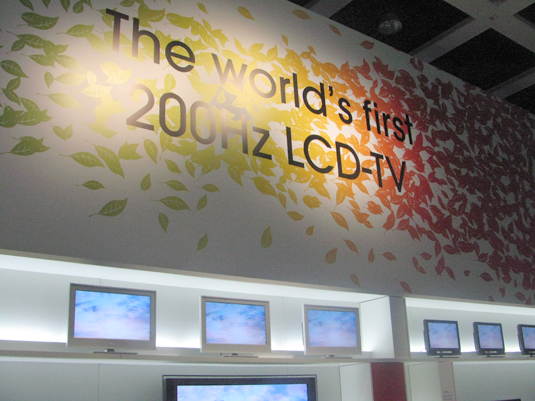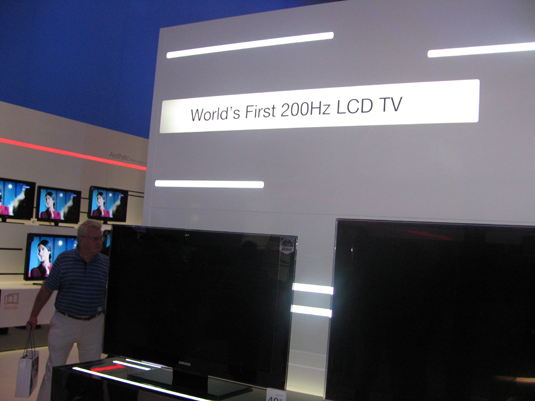 I’ve been spending the day at IFA, the giant consumer electronics show in Berlin that’s Europe’s equivalent of the Consumer Electronics Show in Las Vegas. I’m having a good time, but one conclusion I’ve drawn so far is that CES has the edge when it comes to major announcements about flashy new technologies and jaw-dropping specs. CES isn’t CES without stuff like the world’s first OLED TV or world’s thinnest LCD or the world’s largest plasma. IFA, however, seems to be dominated by more mainstream products and technologies that are cool, but not cutting-edge. You could argue that that’s a good thing, since very few of us will buy the first OLED TV or biggest LCD or thinnest plasma. But it does make for a somewhat more subdued show.
I’ve been spending the day at IFA, the giant consumer electronics show in Berlin that’s Europe’s equivalent of the Consumer Electronics Show in Las Vegas. I’m having a good time, but one conclusion I’ve drawn so far is that CES has the edge when it comes to major announcements about flashy new technologies and jaw-dropping specs. CES isn’t CES without stuff like the world’s first OLED TV or world’s thinnest LCD or the world’s largest plasma. IFA, however, seems to be dominated by more mainstream products and technologies that are cool, but not cutting-edge. You could argue that that’s a good thing, since very few of us will buy the first OLED TV or biggest LCD or thinnest plasma. But it does make for a somewhat more subdued show.
One exception: There’s plenty of hoopla about the first 200-Hz LCD TVs, which run at a faster frame rate to provide smoother action with less motion blur. The company that’s first to market with this breakthrough is justly proud about it. Here’s a snapshot I took in Sony’s booth:

..and here’s one from Samsung’s booth:

Yup–both companies are claiming credit for being the first. (Sony and Samsung share some LCD production, which might explain the synchronicity here.) The dualing firsts kind of point out the silliness of specsmanship in general: Ultimately, it doesn’t matter much which company was first and which one was second. Unless, of course, you’re talking about marketing campaigns. (“The World’s Second 200-Hz TV” just doesn’t have the same ring.)
Is 200-Hz worth getting excited about? The jury’s still out. Samsung has a demo that showed 50-Hz vs. 200-Hz, but it was so obviously rigged that it wasn’t a useful data point: The 50-Hz video was more flickery than a Charlie Chaplin film. I didn’t see any similar comparison at Sony’s both. Both 50-Hz TVs did, indeed, display extremely smooth imagery, but I learned a long time ago not to pay much attention to TV demos at trade shows, since they almost always look gorgeous. What will matter is how much better 200-Hz looks with real-world data sources like cable and satellite TV and standard-def DVDs and Blu-Ray discs almost nobody ever uses those sources when showing off sexy new technologies.
More IFA tidbits to come, and full disclosure: I’m attending the show as a paid speaker at several panels.
 If it weren’t for a certain other laptop-related announcement, the big news in laptops today would undoubtedly be this: Samsung is going to begin selling portable computers again in the U.S., re-entering one of the few personal electronics categories it doesn’t play in. (The company has been out of the market for a long time, with the exception of its Ultra Mobile PC.)
If it weren’t for a certain other laptop-related announcement, the big news in laptops today would undoubtedly be this: Samsung is going to begin selling portable computers again in the U.S., re-entering one of the few personal electronics categories it doesn’t play in. (The company has been out of the market for a long time, with the exception of its Ultra Mobile PC.)
 I’ve been spending the day at IFA, the giant consumer electronics show in Berlin that’s Europe’s equivalent of the Consumer Electronics Show in Las Vegas. I’m having a good time, but one conclusion I’ve drawn so far is that CES has the edge when it comes to major announcements about flashy new technologies and jaw-dropping specs. CES isn’t CES without stuff like the world’s first OLED TV or world’s thinnest LCD or the world’s largest plasma. IFA, however, seems to be dominated by more mainstream products and technologies that are cool, but not cutting-edge. You could argue that that’s a good thing, since very few of us will buy the first OLED TV or biggest LCD or thinnest plasma. But it does make for a somewhat more subdued show.
I’ve been spending the day at IFA, the giant consumer electronics show in Berlin that’s Europe’s equivalent of the Consumer Electronics Show in Las Vegas. I’m having a good time, but one conclusion I’ve drawn so far is that CES has the edge when it comes to major announcements about flashy new technologies and jaw-dropping specs. CES isn’t CES without stuff like the world’s first OLED TV or world’s thinnest LCD or the world’s largest plasma. IFA, however, seems to be dominated by more mainstream products and technologies that are cool, but not cutting-edge. You could argue that that’s a good thing, since very few of us will buy the first OLED TV or biggest LCD or thinnest plasma. But it does make for a somewhat more subdued show.
